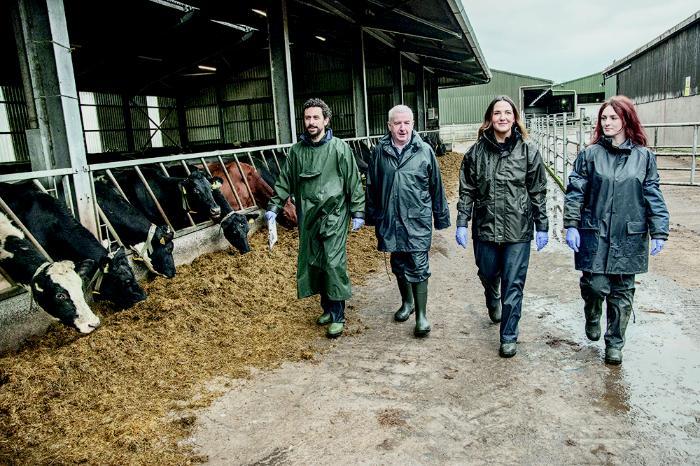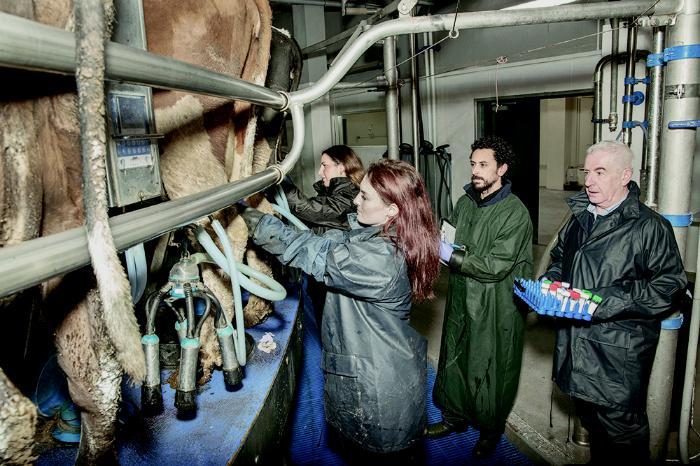21 February 2025
Team spotlight: Udder perfection
Based at Teagasc Moorepark, the mastitis research team is equipping farmers with evidence-based solutions to enhance udder health and reduce reliance on antibiotics. Their research explores key areas such as the risk factors driving clinical and heifer mastitis and the variables influencing the success of non-antibiotic dry cow therapy.

(L-R) Research Officer Pablo Silva Boloña, Lab Manager Jim Flynn and Walsh Scholars Rachael Millar and Natasha Harding are at the forefront of mastitis research at Teagasc Moorepark. Credit: Fergal O’Gorman
The goal of the mastitis research team is to position Teagasc as a leading source for industry guidelines, offering practical tools to help farmers tackle mastitis effectively. This work is timely, given recent legislation emphasising the need to shift away from the preventive use of antibiotics. The team currently comprises Research Officer Pablo Silva Boloña, Milk Quality Laboratory Manager Jim Flynn and Walsh Scholars Rachael Millar and Natasha Harding.
Can you explain the history of this team within Teagasc?
Pablo: The mastitis research team has been continuously evolving and growing over the last few years. I started as a Research Officer in 2019, which involved only one project with one PhD student under my supervision. Now, there are three projects related to mastitis with three PhD students, a technologist, Jim managing the lab and a post-doctoral researcher to join soon.
What specific projects are you currently working on?
Rachael: I am investigating clinical mastitis levels across a cohort of Irish dairy farms. My research examines what bacteria most commonly cause mastitis, and how mastitis occurrences are influenced by management interventions and hygiene practices on farms.
Natasha: I am currently working on a study assessing different somatic cell count (SCC) thresholds, an indicator of mammary gland inflammation to determine cows’ eligibility for non-antibiotic dry therapy and understand its impact on SCC and intramammary infections in the following lactation.
What are your core priorities and objectives?
Pablo: The overall objective of the mastitis programme is to help farmers, through research, to prevent and control mastitis, improve cow health and welfare, and reduce the use of antibiotics associated with this disease.
Natasha: My project’s core focus is exploring the management practices during dry-off and the dry period to support the implementation of non-antibiotic dry cow therapy. The overall aim is to align with EU regulations to effectively reduce antibiotic use across dairy farms, without compromising herd health.
Jim: Part of the objectives of the milk quality lab is to provide technical support for the mastitis research programme in microbiology and cytology, by analysing a large volume of milk samples entering the laboratory. We analyse quarter milk samples for milk composition, SCC and microbiological analysis for the identification of pathogens causing mastitis.
How does your research achieve these objectives?
Pablo: Our work generates knowledge and evidence to tackle mastitis issues, helping to inform the development of guidelines such as the national mastitis control programme, CellCheck. We disseminate our research at national conferences, farm discussion groups, and advisor and veterinary training, among other initiatives.
Rachael: We aim to reflect what farmers are doing at ground level in terms of mastitis management and intend to present results to them and to the wider dairy industry. To make my work applicable to most farmers in Ireland, a cohort of 82 randomly selected dairy farmers across the country were chosen to participate in my study. There are farms from each province in the country – 69.5% from Munster, 14.6% from Leinster and 15.9% from Ulster and Connacht.
Natasha: My research emphasises farmer collaboration for designing the studies, allowing their perspective to help shape approaches. We aim to develop guidelines for non-antibiotic dry cow therapy that are practical and can be tailored to the needs of individual herds.
“Identifying cows affected with mastitis and the main bacteria causing intramammary infections… is key to determining what management factors
might be causing a problem.”
Jim: Our work contributes to identifying cows affected with mastitis and the main bacteria causing intramammary infections. This is key information to determine what management factors might be causing a problem and how to control it.
What are the key techniques and tools you use to achieve this work?
Rachael: I am collecting data by visiting the 82 farms three times throughout the lactation, a first in Ireland. During visits, I assess farm facilities, milking routines and the hygiene of the cows and the environment. Also, I conduct a questionnaire with the farmer to understand general farm management, mastitis management and treatment protocols. All farmers have agreed to, and been trained on, taking aseptic quarter milk samples of clinical mastitis cases for us to learn what bacteria are causing it.
Natasha: I am using a controlled study across research herds to evaluate SCC thresholds and alternative selection methods for assigning cows’ non-antibiotic therapy at dry-off. The approach allows for the validation, in a research setting, of on-farm practical tools to effectively and safely dry-off cows. This also helps provide tools for farmers that may not record milk samples – and therefore don’t have SCC data – to make the right decisions around non-antibiotic dry cow therapy.
Jim: From six Teagasc research farms, we analyse approximately 98,000 milk samples annually for milk composition and SCC using the CombiFoss instrument. For our microbiology tests, we usually analyse thousands of quarter samples each year by plating the milk on blood agar (non-selective agar with 7% sheep blood), whilst also conducting confirmatory tests using selective agars such as Baird Parker, Edwards and McConkey.
Can you explain the importance of your work in the context of Irish farming and agriculture?
Rachael: Clinical mastitis is a common disease in dairy cattle and results in huge economic loss. By investigating farm management, facilities and farm hygiene, and analysing mastitis milk samples to determine pathogens present on each farm, this research provides valuable insights to enhance control and prevention of clinical mastitis.
Natasha: Exploring and identifying key tests to identify infected cows at the end of lactation and support the assignment of cows to non-antibiotic dry cow therapy will contribute to farmers’ confidence in the practice while maintaining udder health.
The project supports sustainable practices that align with EU policies while emphasising the importance of maintaining herd health, milk quality and animal welfare, and safeguarding Ireland’s reputation in the dairy industry.
In 2023, the dairy industry saw a 20% reduction in antibiotic use.
Jim: We provide accurate real-time data, enabling farmers and farm managers to monitor individual cow SCC and researchers to monitor milk quality on the different trials ongoing in commercial and Teagasc research farms. We also identify the pathogens causing high SCC, helping identify cows that should be treated accordingly. I’ve been working in the milk quality laboratory since 1990 and have been involved in numerous different trials including the development of alternative mastitis treatments, non-antibiotic dry cow therapy and effectiveness of disinfectants in reducing mastitis, among others.
What results have you seen so far?
Pablo: The work is recent and continues to be carried out. However, we have seen an increase in the uptake of non-antibiotic dry cow therapy – from almost every cow being treated with antibiotic at dry-off, to close to 80% being treated with antibiotic in 2023, an almost 20% reduction in antibiotic use. We’re seeing greater awareness by dairy farmers and the industry of the importance of milk recording and an increasing knowledge of things that work and do not work around mastitis management and the implementation of non-antibiotic dry cow therapy.
How does your team’s work sit within the wider Teagasc organisation?
Pablo: We contribute to Teagasc by publishing research results in the top scientific journals in the field, increasing the organisation’s research status, and developing new project proposals to bring in external funding. Engaging with farmers and the wider industry helps keep Teagasc relevant to key stakeholders and heightens the work’s impact. We strive to deliver research that is of excellent quality, is relevant to dairy farmers and the industry and improves the health of dairy cows. Keeping these values in mind helps us contribute positively to the dairy industry in Ireland.
Meet the team

Improving understanding of the underlying causes behind mastitis is a vital step towards reducing antibiotic use. Credit: Fergal O’Gorman
What are you proudest of as a member of the team?
Rachael: I am proud of the work that I have carried out so far, with the organisational challenges involved in planning each farm visit and with over 500 samples analysed in the lab so far. I would like to acknowledge the 82 farmers for their endless efforts and interest in every aspect of the trial, without whom none of this would be possible.
Natasha: As a new member, I’m proud to be part of a team focused on sustainable farming. While I’m just starting, I look forward to contributing to impactful research in the near future.
Jim: The volume of samples that I and other members of the laboratory team have analysed in the different trials – some submitting over 8,000 samples for analysis in a very short time. I am also proud of having set up the method to measure trichloromethane (TCM) in milk for the dairy industry and to have been able to significantly reduce its levels in butter in a short space of time.
Pablo: I’m proud to be delivering evidence-based work to control mastitis in Ireland. I’m excited with how the programme and team have developed and look forward to our continued evolution.
To learn more about the Teagasc mastitis research team’s work, check out these informative videos:
